This article was co-authored by Monica Kieu, DO, FACS and by wikiHow staff writer, Megaera Lorenz, PhD. Dr. Monica Kieu is a board certified Otolaryngologist and Specialist in Facial Plastic and Reconstructive Surgery in Los Angeles, California. Dr. Kieu received a BS in Anthropology from the University of California, Riverside and earned her medical degree (DO), with honors, from Western University of Health Sciences in Pomona. She then completed her residency in Otolaryngology-Head and Neck Surgery at Michigan State University/Detroit Medical Center, where she served as chief resident. Dr. Kieu also completed a prestigious fellowship in Facial Plastic and Reconstructive Surgery at the University of Toronto. She is a member of the American Academy of Otolaryngology-Head and Neck Surgery, American Osteopathic Colleges of Ophthalmology and Otolaryngology-Head and Neck Surgery, American Academy of Cosmetic Surgery, American Academy of Facial Plastic and Reconstructive Surgery, and the American Rhinologic Society. Dr. Kieu was recently named one of LA’s Top Docs by Los Angeles Magazine.
There are 15 references cited in this article, which can be found at the bottom of the page.
wikiHow marks an article as reader-approved once it receives enough positive feedback. This article received 15 testimonials and 81% of readers who voted found it helpful, earning it our reader-approved status.
This article has been viewed 5,874,208 times.
Although earwax is a natural substance that helps protect the ear and ear canal, otolaryngologist Monica Kieu agrees that it can sometimes build up, causing hearing difficulties or discomfort.[1] If you're experiencing severe symptoms, like ringing in your ears, difficulty hearing, or dizziness, see a doctor since you may have an ear infection or other more serious condition. However, for simple maintenance, you can remove excess earwax with ear-safe substances like saline solution, hydrogen peroxide, or mineral oil. No matter what, however, always make sure to be gentle with your ears, so you don't cause more harm than good.
Steps
Cleaning Your Ears with Liquid Solutions
-
1Rinse your ears with saline solution. A saline rinse is a gentle and effective solution for getting wax out of your ears. Soak a cotton ball with the solution, then tilt the affected ear toward the ceiling and squeeze a few drops into your ear. Keep your head tilted to the side for 1 minute to allow the saline to soak in, then tilt it the other way to let it flow out.[2]
- Gently dry your outer ear with a towel when you’re done.
- You can buy pre-made sterile saline solution at the drug store, or make your own by mixing 4 cups (950 mL) of distilled water with 2 teaspoons (11.4 g) of noniodized salt.[4] You can use tap water instead of distilled water, but you should boil it for at least 20 minutes and allow it to cool before use.
- If your earwax is hard and impacted, you may need to soften it first with a few drops of hydrogen peroxide, baby oil, or commercial earwax remover.[5]
Tip: Use water that’s as close to your body temperature as possible. Using water that’s cooler or warmer than your body can cause vertigo.[3]
-
2Soften stubborn earwax with hydrogen peroxide. Hydrogen peroxide has the added advantage of being able to dissolve hardened earwax. To clean your ears, dip a clean cotton ball in a solution of 1 part water and 1 part hydrogen peroxide or pull a few drops into a medicine dropper or syringe bulb. Tilt your ear up and let 3-5 drops flow in, wait 5 minutes, then tilt your ear down to let the fluid flow out again.[6]
- You may wish to follow up with a plain water or saline rinse.
- You can use this solution 2 to 3 times a day for up to a week. Stop and consult your doctor if you experience pain or irritation in your ears.
Advertisement -
3Try baby or mineral oil as an alternative to hydrogen peroxide. Much like hydrogen peroxide, baby or mineral oil can help soften stubborn earwax, making it easier to remove. Use a medicine dropper to put 2 to 3 drops of oil in your ear, then hold your ear facing up for 2-3 minutes so the oil has a chance to soak in. When you’re done, tilt your head to the side to let the oil and wax run out.[7]
- You can also use glycerin for this purpose.
- Try using oil to pre-soften your earwax before rinsing your ears with saline solution.
-
4Use alcohol and white vinegar to dry out moist ears. A mixture of alcohol and white vinegar can help cleanse your ears and also dry out extra moisture that might lead to irritation and infection. Mix 1 teaspoon (4.9 mL) of white vinegar with 1 teaspoon (4.9 mL) of rubbing alcohol in a clean cup. Draw some of the mixture into an eyedropper and let 6-8 drops run into your upturned ear. Let the mixture run all the way down your ear canal, then tilt your head to let it run out again.[8]
- If your ears are chronically moist, you can use this solution twice a week for a few months if your doctor recommends it. However, stop and consult your doctor if you experience irritation or bleeding.
Avoiding Common Mistakes
-
1Use cotton swabs for shallow cleaning only. Cotton swabs can be used in the outer ear to remove superficial earwax, but otolaryngologist Monica Kieu advises against digging into the ear canal with a cotton swab.[9] The tissue in your ear canal is extremely delicate; it's easy to cause damage by smashing into any of the tissue near the tympanic membrane, or eardrum.[10]
- Cotton swabs can also push wax deeper into your ear, potentially causing blockages, damage, or irritation.[11]
-
2Stay away from ear candles. Ear candling is a procedure that involves placing a cone-shaped device into the ear and lighting a candle on the far end of the spout. This procedure is supposed to create a vacuum that draws wax and impurities out of the ear. Ear candling is not only ineffective, however, but it can also cause a variety of injuries and ear problems, including:[12]
- Bleeding from the ears
- Perforated eardrums
- Burns to your face, hair, scalp, or ear canal[13]
Warning: Much like improperly used cotton swabs, ear candles can also push earwax further into the ear canal, leading to blockages.
-
3Don't spray any liquids into your ear with force. Doctors may do this, but you should not. Liquids that are thrust into the ear canal may get past the tympanic membrane and cause an ear infection or damage your inner ear.[14]
- When irrigating your ears, use a dropper, cotton ball, or syringe bulb to gently introduce the liquid a drop at a time.
- Never put any liquid into your ear if you have a perforated eardrum or surgically implanted tubes in your ears.[15]
Getting a Medical Evaluation and Treatment
-
1See your doctor if you have symptoms of an earwax blockage. If you think you might have excessive earwax in your ear, otolaryngologist recommends making an appointment with your doctor. They can not only safely remove any excess earwax, but can also make sure your symptoms are not a sign of a more serious underlying issue.[16] See your doctor if you experience symptoms such as:[17]
- An earache
- A feeling of blockage or fullness in your ear
- Itchiness in your ear
- Pain when touching your ear
- Difficulty hearing
- Ringing in your ear
- Dizziness
- A cough that isn’t explained by a cold or other condition
Did you know? Hearing aids can stimulate the production of wax in your ear, and the wax can eventually damage your hearing aids. If you wear hearing aids, see your doctor regularly to check for excessive wax buildup.[18]
-
2Ask your doctor to rule out an infection or other underlying condition. According to otolaryngologist Monica Kieu, if you have an ear infection or an ear injury that is contributing to your symptoms, it’s important to get a proper diagnosis and treatment to prevent further damage. Additionally, an infection or other problem with your ear (such as an injured eardrum) could make cleaning your ears dangerous.[19]
- If you have an ear infection, your doctor may prescribe antibiotics to help clear it up. You should not put liquids or objects (such as cotton swabs) into an infected ear unless your doctor instructs you to do so.
- Don’t try to clean wax out of your ears on your own if you have an injured eardrum or an object stuck in your ear.[20]
-
3Discuss having excess wax removed in the doctor’s office. If you have excess earwax and don’t want to attempt to remove it on your own, your doctor may be able to perform a simple in-office procedure to clean your ears. Ask them if they can remove your earwax with a curette (a curved instrument designed to scrape the wax out of your ear canal) or a warm water rinse.[21]
- Your doctor may also prescribe medicated eardrops to help remove excess wax from your ear. Follow the instructions on these products carefully, since they can irritate your eardrums and ear canals if you use them incorrectly.
How Do You Clean Your Ears?
Expert Q&A
Did you know you can get premium answers for this article?
Unlock premium answers by supporting wikiHow
-
QuestionWhat's a safe way to clean your ears?
 Monica Kieu, DO, FACSDr. Monica Kieu is a board certified Otolaryngologist and Specialist in Facial Plastic and Reconstructive Surgery in Los Angeles, California. Dr. Kieu received a BS in Anthropology from the University of California, Riverside and earned her medical degree (DO), with honors, from Western University of Health Sciences in Pomona. She then completed her residency in Otolaryngology-Head and Neck Surgery at Michigan State University/Detroit Medical Center, where she served as chief resident. Dr. Kieu also completed a prestigious fellowship in Facial Plastic and Reconstructive Surgery at the University of Toronto. She is a member of the American Academy of Otolaryngology-Head and Neck Surgery, American Osteopathic Colleges of Ophthalmology and Otolaryngology-Head and Neck Surgery, American Academy of Cosmetic Surgery, American Academy of Facial Plastic and Reconstructive Surgery, and the American Rhinologic Society. Dr. Kieu was recently named one of LA’s Top Docs by Los Angeles Magazine.
Monica Kieu, DO, FACSDr. Monica Kieu is a board certified Otolaryngologist and Specialist in Facial Plastic and Reconstructive Surgery in Los Angeles, California. Dr. Kieu received a BS in Anthropology from the University of California, Riverside and earned her medical degree (DO), with honors, from Western University of Health Sciences in Pomona. She then completed her residency in Otolaryngology-Head and Neck Surgery at Michigan State University/Detroit Medical Center, where she served as chief resident. Dr. Kieu also completed a prestigious fellowship in Facial Plastic and Reconstructive Surgery at the University of Toronto. She is a member of the American Academy of Otolaryngology-Head and Neck Surgery, American Osteopathic Colleges of Ophthalmology and Otolaryngology-Head and Neck Surgery, American Academy of Cosmetic Surgery, American Academy of Facial Plastic and Reconstructive Surgery, and the American Rhinologic Society. Dr. Kieu was recently named one of LA’s Top Docs by Los Angeles Magazine.
Board Certified Otolaryngologist
Warnings
- If you are experiencing ear pain, a fever, loss of hearing or ringing in the ears, do not attempt any home remedies for removing earwax unless your physician recommends it.⧼thumbs_response⧽
References
- ↑ https://www.nhsinform.scot/illnesses-and-conditions/ears-nose-and-throat/earwax-build-up
- ↑ https://www.health.harvard.edu/staying-healthy/got-an-ear-full
- ↑ https://medlineplus.gov/ency/article/000979.htm
- ↑ https://www.medicalnewstoday.com/articles/323842.php
- ↑ https://www.mayoclinic.org/diseases-conditions/earwax-blockage/diagnosis-treatment/drc-20353007
- ↑ https://www.medicalnewstoday.com/articles/322725.php
- ↑ https://www.medicalnewstoday.com/articles/319421.php
- ↑ https://journals.lww.com/thehearingjournal/fulltext/2010/03000/How_to_care_for_moist_ears.12.aspx
- ↑ https://my.clevelandclinic.org/health/diseases/14428-ear-wax-buildup--blockage
- ↑ https://www.nhsinform.scot/illnesses-and-conditions/ears-nose-and-throat/earache
- ↑ https://www.mayoclinic.org/diseases-conditions/earwax-blockage/symptoms-causes/syc-20353004
- ↑ https://www.medicalnewstoday.com/articles/322247.php
- ↑ https://www.mayoclinic.org/healthy-lifestyle/consumer-health/expert-answers/ear-candling/faq-20058212
- ↑ https://medlineplus.gov/ency/article/000979.htm
- ↑ https://my.clevelandclinic.org/health/diseases/14428-ear-wax-buildup--blockage/management-and-treatment
- ↑ https://www.mayoclinic.org/diseases-conditions/earwax-blockage/symptoms-causes/syc-20353004
- ↑ Monica Kieu, DO, FACS. Board Certified Otolaryngologist. Expert Interview. 20 October 2020.
- ↑ https://www.health.harvard.edu/staying-healthy/got-an-ear-full
- ↑ https://www.nhsinform.scot/illnesses-and-conditions/ears-nose-and-throat/earache
- ↑ Monica Kieu, DO, FACS. Board Certified Otolaryngologist. Expert Interview. 20 October 2020.
- ↑ https://www.mayoclinic.org/diseases-conditions/earwax-blockage/diagnosis-treatment/drc-20353007
About This Article
Before you try to get rid of earwax on your own, visit your doctor if you're experiencing severe symptoms, like ringing in your ears, difficulty hearing, dizziness, or an earache, since they could be the sign of an underlying issue. If you're not experiencing serious symptoms, you can try getting rid of the earwax at home using a saline solution. First, mix 1 teaspoon of salt and 1/2 cup of warm water until the salt dissolves. Then, soak a cotton ball in the solution and tilt your head so that the ear you want to treat is facing up to the ceiling. Squeeze some of the solution into the affected ear, and then tilt your head to the other side after 1 minute to drain the solution, along with some built up ear wax. For tips from our Medical co-author, like how to use hydrogen peroxide or vinegar to get rid of earwax, keep reading!


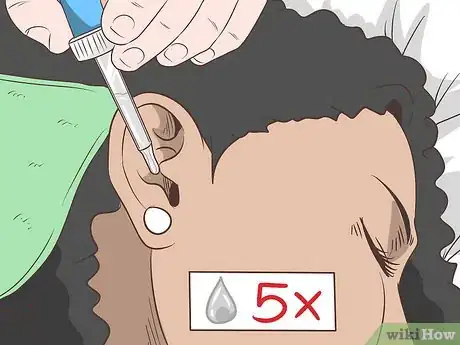

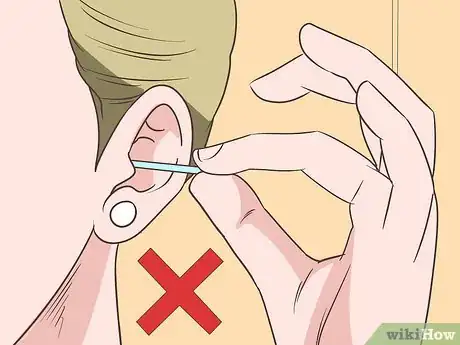
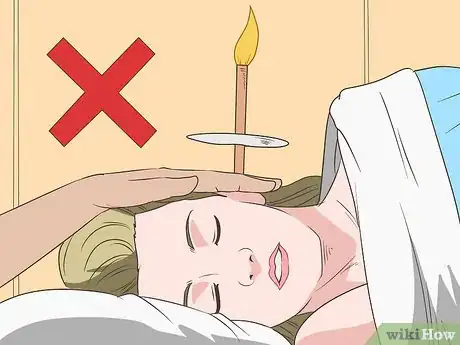



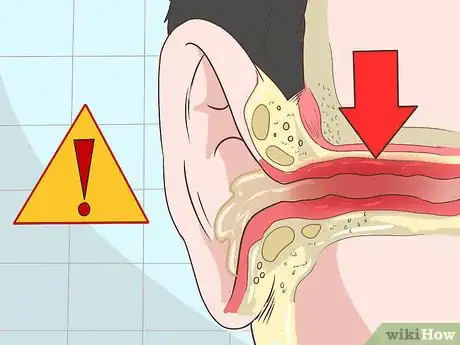
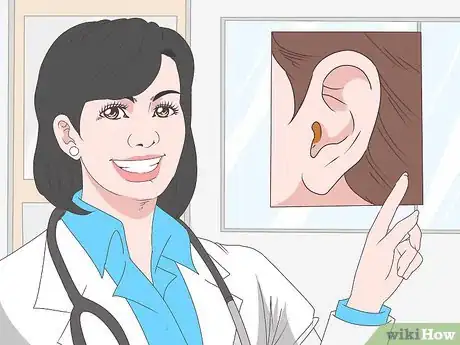
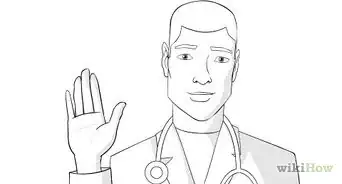










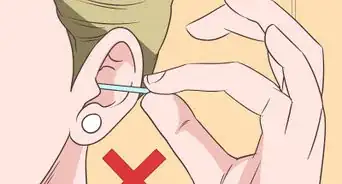




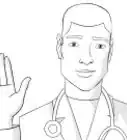
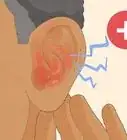






































Medical Disclaimer
The content of this article is not intended to be a substitute for professional medical advice, examination, diagnosis, or treatment. You should always contact your doctor or other qualified healthcare professional before starting, changing, or stopping any kind of health treatment.
Read More...